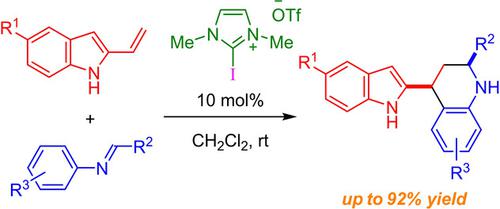当前位置:
X-MOL 学术
›
Adv. Synth. Catal.
›
论文详情
Our official English website, www.x-mol.net, welcomes your
feedback! (Note: you will need to create a separate account there.)
Non‐Bonding Electron Pair versus π‐Electrons in Solution Phase Halogen Bond Catalysis: Povarov Reaction of 2‐Vinylindoles and Imines
Advanced Synthesis & Catalysis ( IF 4.4 ) Pub Date : 2020-06-02 , DOI: 10.1002/adsc.202000494 Takumi Suzuki 1 , Satoru Kuwano 1 , Takayoshi Arai 1
Advanced Synthesis & Catalysis ( IF 4.4 ) Pub Date : 2020-06-02 , DOI: 10.1002/adsc.202000494 Takumi Suzuki 1 , Satoru Kuwano 1 , Takayoshi Arai 1
Affiliation

|
The non‐bonding electron pair (n‐pair) of heteroatoms and π‐electrons are both efficient halogen bond (XB) acceptors. In solid and gas phase studies, n‐pairs generally prevail over π‐bonding orbitals as XB acceptors, whereas few studies have been conducted regarding the preference in solution phase. Herein, the Povarov reaction via the C−I⋅⋅⋅N XB interaction and [4+2] cycloaddition via the C−I⋅⋅⋅π XB interaction were evaluated, revealing that the n‐pair was more dominant in the XB catalysis system in solution. The XB donor‐catalyzed Povarov reaction gave diverse indolyl‐tetrahydroquinoline derivatives in good yields. Synthesis of indolyl‐quinolines was also developed.
中文翻译:

溶液相卤素键催化中的非键电子对与π电子:2-Vilinlindoles和亚胺的Povarov反应
杂原子和π电子的非键电子对(n对)都是有效的卤素键(XB)受体。在固相和气相研究中,n对通常胜过π键轨道作为XB受体,而关于固溶相偏好的研究很少。在本文中,对通过C–I⋅⋅·N XB相互作用的Povarov反应和通过C–I⋅⋅⋅π XB相互作用的[4 + 2]环加成进行了评估,表明n对在XB催化中占主导地位。解决方案中的系统。XB供体催化的Povarov反应以良好的收率得到了多种吲哚基-四氢喹啉衍生物。还开发了吲哚基喹啉的合成方法。
更新日期:2020-08-04
中文翻译:

溶液相卤素键催化中的非键电子对与π电子:2-Vilinlindoles和亚胺的Povarov反应
杂原子和π电子的非键电子对(n对)都是有效的卤素键(XB)受体。在固相和气相研究中,n对通常胜过π键轨道作为XB受体,而关于固溶相偏好的研究很少。在本文中,对通过C–I⋅⋅·N XB相互作用的Povarov反应和通过C–I⋅⋅⋅π XB相互作用的[4 + 2]环加成进行了评估,表明n对在XB催化中占主导地位。解决方案中的系统。XB供体催化的Povarov反应以良好的收率得到了多种吲哚基-四氢喹啉衍生物。还开发了吲哚基喹啉的合成方法。











































 京公网安备 11010802027423号
京公网安备 11010802027423号